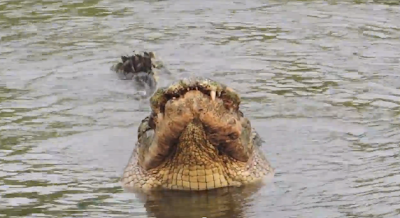What a pleasant surprise to find this place! We were on vacation in the area and decided to go to the zoo. Truthfully, there are so many choices when on vacation a zoo isn't usually at the top of the list. We were very glad we decided to visit.
The Virginia Zoo in Norfolk, Virginia is lovely, from the grand entrance with the huge granite ball and fountain, to the new Trail of the Tiger area, to the unique themed garden areas planted throughout the zoo. Even if the zoo didn't have any animals it would be a nice place to take a walk. But, of course, they have plenty of animals, and you can get up close and good views of just about everything.
 The highlight of the day for us was the red panda mother and her six week old cubs. Some of the monkeys were putting on quite a show, too, but the cuteness of a red panda cub is tough to match. Watching the mother carry her cub was priceless. You can see some of the video and learn more about red pandas in the YouTube video Have you heard of Red Pandas?
The highlight of the day for us was the red panda mother and her six week old cubs. Some of the monkeys were putting on quite a show, too, but the cuteness of a red panda cub is tough to match. Watching the mother carry her cub was priceless. You can see some of the video and learn more about red pandas in the YouTube video Have you heard of Red Pandas?I always like zoos that have animal caretakers or volunteers available to answer questions and provide those little tidbits of information about the animals. This is great for the families with young kids because it really helps keep the kids engaged. The staff at the zoo was often present, nearby and willing and able to answer our questions. There were also signs posted about zoo keeper talk times too, but, unfortunately, we didn't happen to catch any of those.
 Another nice feature of this zoo is the large raised walkway around the giraffe area. It is nice to be able to see the giraffes and other animals from an elevated viewpoint. There are a large number of animal exhibits you can look down into, including the bongos, African crowned crane, elephants, and more.
Another nice feature of this zoo is the large raised walkway around the giraffe area. It is nice to be able to see the giraffes and other animals from an elevated viewpoint. There are a large number of animal exhibits you can look down into, including the bongos, African crowned crane, elephants, and more.If you're on vacation in Virginia and considering going to the Virginia Zoo but haven't quite decided yet, I'd say go for it! Hopefully you'll have an animal adventure to remember.
If you do go and get any good pictures please share them with us on the Skyenimals Facebook page and on Skyenimals.com! Want to see more of our photos from our visit? Check out the Skyenimals Virginia Zoo page.




















